Invasive species pose a significant threat to ecosystems worldwide, and Illinois is no exception. In this article, we dive deep into some of Illinois’s most prevalent invasive species. We discuss their impacts on the local ecosystem, and what experts are doing to manage or mitigate their effects.
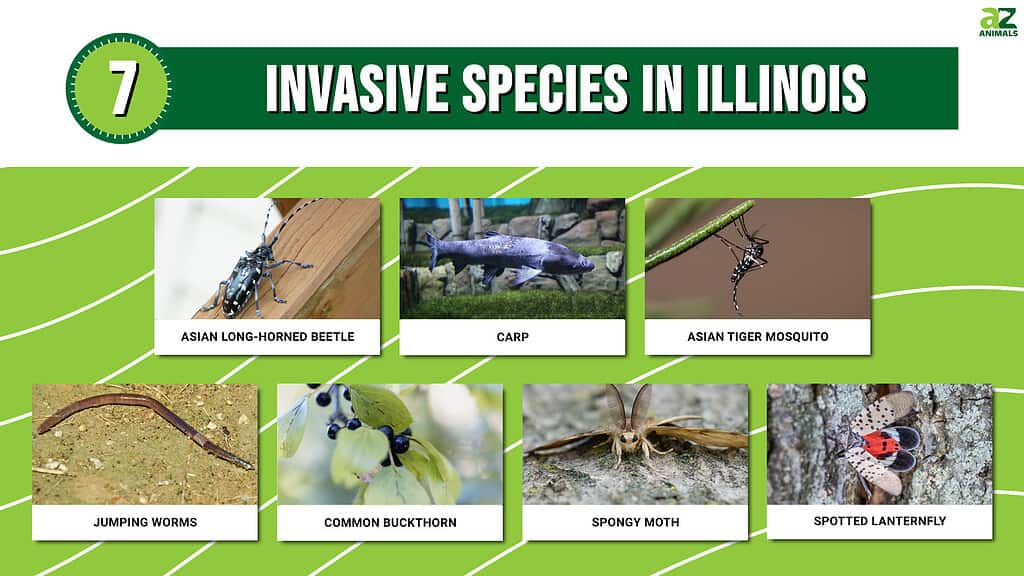
Asian Long-Horned Beetle (Anoplophora glabripennis)
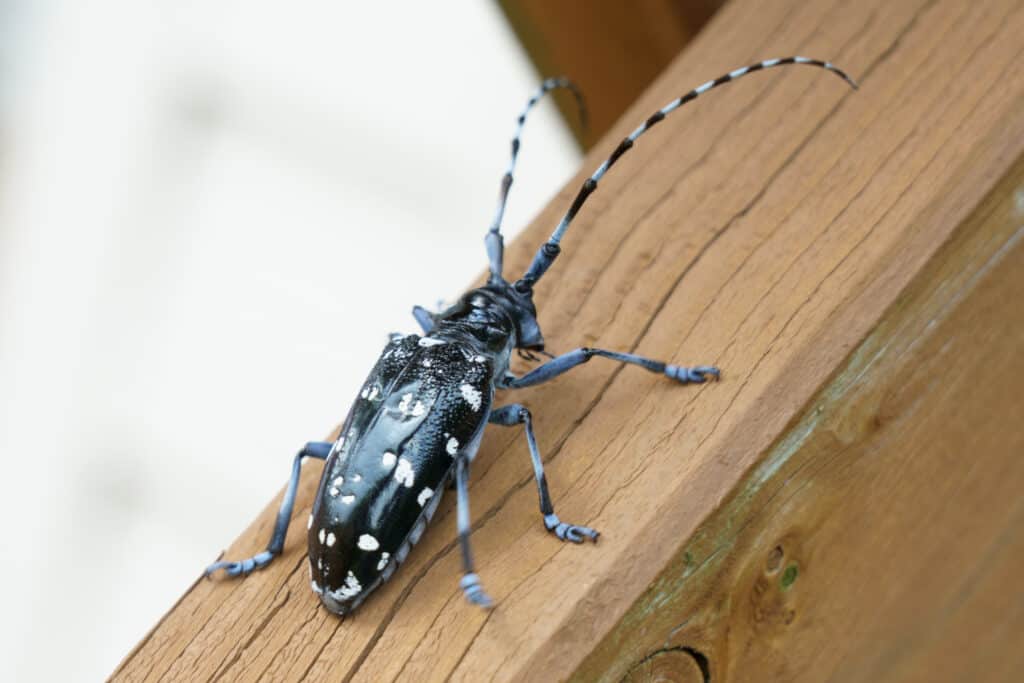
This wood-boring insect is invasive due to its destructive feeding habits.
©High Mountain/Shutterstock.com
The Asian long-horned beetle, often abbreviated as ALB, is an unwelcome intruder in Illinois. This foreign invader originates from China and the Korean Peninsula and is easily recognizable due to its unique appearance. The beetle is huge, typically around 1.5 inches long, with a glossy, jet-black body and white spots. Its most distinguishing feature is its pair of exceptionally long antennae, which have black and white bands.
This wood-boring insect is invasive due to its destructive feeding habits. The adult beetles lay their eggs in the bark of trees. And when they hatch, the larvae bear deep into the tree to feed on the heartwood. This feeding disrupts the tree’s vascular system and eventually leads to its death. The beetles are not selective and attack a wide range of hardwood trees, including maple, birch, elm, willow, and ash.
Introducing the Asian long-horned beetle into Illinois is causing significant harm to the local ecosystems. This insect’s incredible appetite and broad host range have led to tens of thousands of tree deaths. They have altered habitats, affected biodiversity, and disrupted the balance of local ecosystems. This impacts wildlife and has economic consequences for industries dependent on these trees, including timber, nursery, and maple syrup production.
Furthermore, urban and suburban areas suffer aesthetically and practically from the loss of shade trees. And these trees contribute to air purification and temperature regulation. Consequently, the Asian long-horned beetle has become a high-priority pest for eradication efforts. Officials seek to prevent its further spread and to safeguard the health of Illinois’ treasured forests and urban tree canopies.
Carp (Cyprinus carpio)
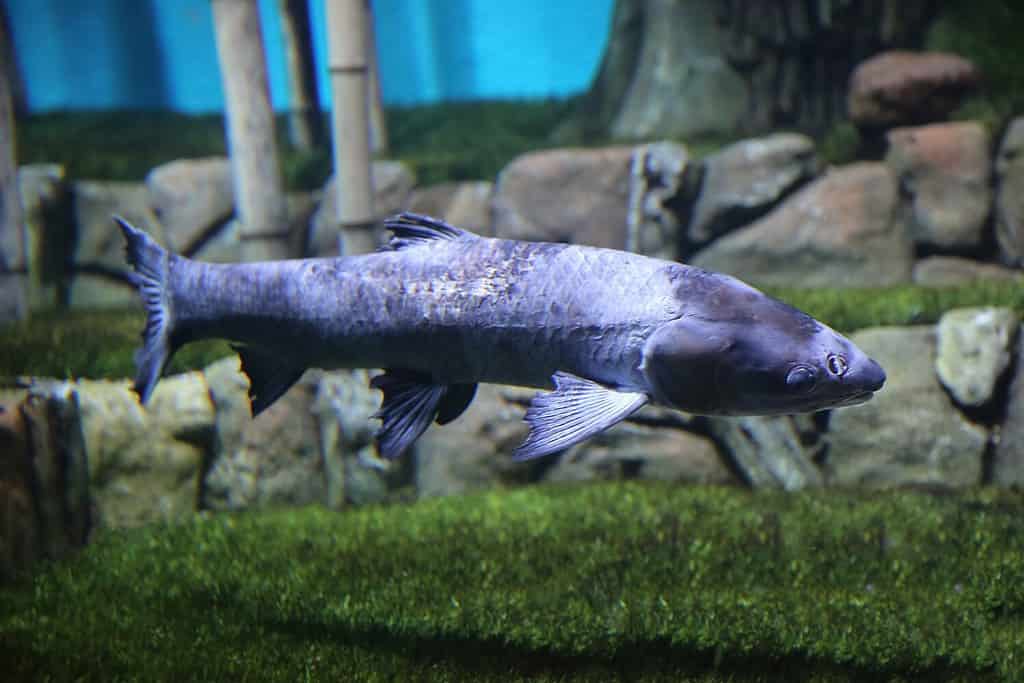
Regarded as invasive, these fish are notorious for their high reproduction rates.
©ivSky/Shutterstock.com
Carp species are an escalating problem in Illinois. These fish are originally from Eastern Asia and Europe. People brought them to the United States in the 1970s. They came over as biological control agents in fish farms to tackle algae, weeds, and parasites. However, they inadvertently found their way into the Mississippi River system.
These carp species are sizable, often tipping the scales at 40 pounds or more. They feature a unique mouth that points downward, for filter-feeding. Bighead carp exhibit a dark gray hue with prominent scales. Silver carp are more reflective, bearing a top side of silver-blue that lightens to silver-white on their underbelly.
Regarded as invasive, these fish are notorious for their high reproduction rates. They also consume plankton, the primary food source for many aquatic organisms. This intense competition for resources leaves native species struggling to survive. Silver carp, in particular, are infamous for their ability to leap out of the water when startled, which creates hazards for boaters.
Carp have wreaked havoc on the local ecosystems. Their ability to outcompete native fish species for food and breeding areas has led to a sharp decline in the populations of native species. This imbalance has a ripple effect throughout the food chain, possibly leading to a drop in the diversity of wildlife.
Moreover, the carp invasion carries economic implications, posing a severe threat to the state’s recreational fishing industry. As a result, significant efforts are underway to halt the further spread of these fish, especially towards the Great Lakes, where their potential impact on aquatic habitats could be disastrous.
Asian Tiger Mosquito (Aedes albopictus)
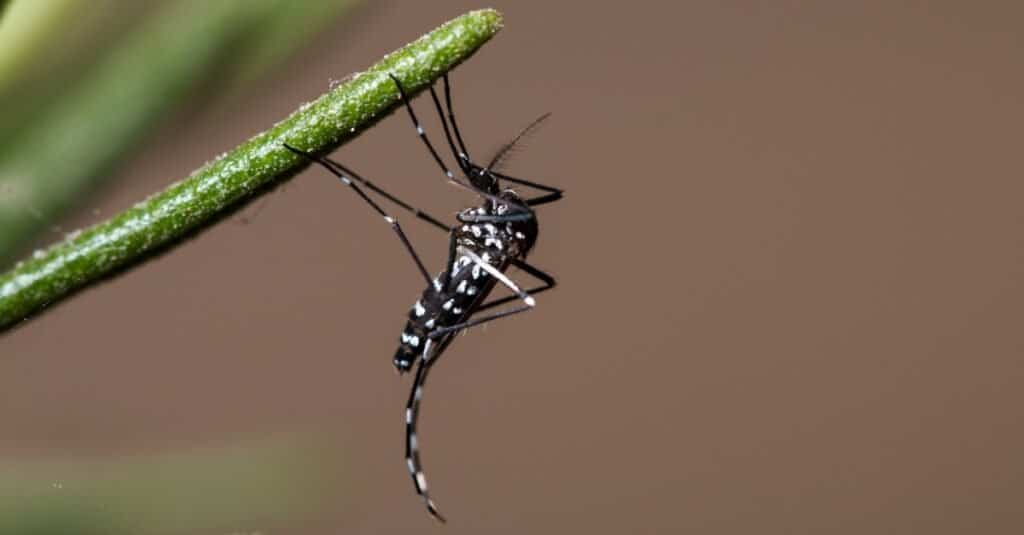
The Asian
tiger
mosquito is relatively small, about ¼ inch long, but is easily identifiable by its black and white striped pattern on its body and legs.
©Oliver Spiteri/Shutterstock.com
The Asian tiger mosquito is an intruder causing substantial concern in Illinois. Hailing from Southeast Asia, this species was likely introduced through international trade, specifically the used tire trade, which provided a perfect environment for eggs to hitch a ride.
The Asian tiger mosquito is relatively small, about ¼ inch long, but is easily identifiable by its black and white striped pattern on its body and legs, hence the “tiger” in its name. It also possesses a single median silver-white stripe running down its dorsal side.
Regarded as an invasive species, the Asian tiger mosquito is notorious for its aggressive daytime feeding behavior and ability to transmit numerous diseases, such as Zika virus and yellow fever. Unlike many other mosquito species that prefer cleaner water, the Asian tiger mosquito is not picky, laying its eggs in any water-filled container, natural or artificial, making it a common pest in urban areas.
Jumping Worms (Amynthas agrestis)

Recognizable by their unique behavior and physical traits, jumping worms can grow up to 8 inches long, and have smooth, glossy skin.
©iStock.com/Arrlxx
Jumping worms are a recent concern in Illinois. These invasive earthworms originate from East Asia but have made their way to the United States, likely through the horticultural trade.
Recognizable by their unique behavior and physical traits, jumping worms can grow up to 8 inches long, are dark brown to gray, and have smooth, glossy skin. Their name comes from their energetic, snake-like thrashing movement when disturbed. A distinctive characteristic is their clitellum (the band on many worms), which is milky-white to gray and completely encircles their body.
The invasive status of these worms stems from their aggressive feeding habits and rapid reproduction. Unlike native worms that burrow deep into the soil, jumping worms stay in the top layers, consuming the organic matter much faster than their native counterparts. This alters the soil structure, turning it granular, similar to spent coffee grounds.
In Illinois, the invasion of these worms poses a significant threat to the ecosystem. Depleting the topsoil of its nutrients disrupt the natural nutrient cycle, affecting the growth and survival of various plants, including understory vegetation and forest seedlings. This can lead to soil erosion and make landscapes more susceptible to invasive plant species.
Common Buckthorn (Rhamnus cathartica)
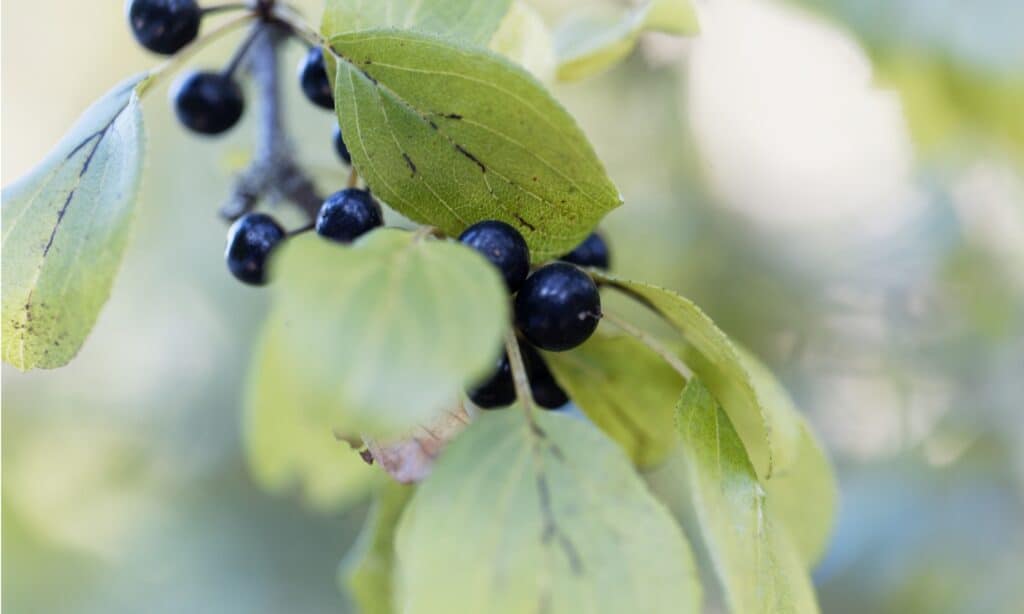
Common buckthorn is a deciduous shrub that can grow up to 20 feet tall, with dark, glossy green leaves and dark gray to brown bark.
©iStock.com/weisschr
Buckthorn, particularly the common buckthorn, is invasive in Illinois. This plant species is native to Europe, Asia, and North Africa. Newcomers introduced them to North America as ornamental shrubs and for wildlife habitat. However, their rapid spread and negative impacts on native ecosystems have made them unwelcome guests.
Common buckthorn is a deciduous shrub that can grow up to 20 feet tall, with dark, glossy green leaves and dark gray to brown bark. The plant produces small, greenish flowers and clusters of black, pea-sized berries.
Buckthorn is invasive due to its ability to multiply, spread aggressively, and outcompete native plants for light, nutrients, and space. It is highly adaptable and can thrive in a variety of habitats, such as woodlands, prairies, and wetlands. Moreover, the plant produces many seeds that birds andother wildlife easily disperse.
In Illinois, the proliferation of buckthorn poses a significant threat to the local ecosystems. By forming dense thickets, it shades out native plants and tree seedlings, leading to a decline in plant diversity and altering the structure of native habitats. This can impact the wildlife dependent on these native plants for food and shelter. Additionally, buckthorn can serve as a host for pests and diseases, such as the soybean aphid and the crown rust fungus, affecting crops and native plants.
Efforts are being made to manage and control the spread of buckthorn in Illinois, with an emphasis on early detection and removal. Techniques such as mechanical removal, prescribed burns, and herbicide application are often used to eradicate or control the growth of this invasive plant. Public education and outreach are essential to these management efforts, encouraging native alternatives in landscaping and restoration projects.
Spongy Moth (Lymantria dispar)

This moth is considered invasive due to its voracious feeding habits in its
caterpillar
stage.
©iStock.com/Wirestock
The spongy moth is another unwelcome intruder in Illinois. Originally from Europe and Asia, this insect was introduced to North America in the late 19th century in a failed attempt to establish a silk industry.
In its larval stage, the spongy moth caterpillar is unmistakable. The caterpillars can grow up to 2-3 inches long. They have a dark body covered in bristles and a pattern of blue and red dots along its back. Adult moths differ in appearance based on sex. Males are smaller with brownish-gray wings, while females are larger with whitish wings marked by dark, wavy bands.
This moth is considered invasive due to its voracious feeding habits in its caterpillar stage. The caterpillars feed on the leaves of over 500 species of trees and shrubs, with a preference for oak trees. The females lay masses of eggs, which leads to high populations of caterpillars that can defoliate large sections of forests when feeding.
In Illinois, the spongy moth invasion severely threatens the state’s ecosystems. Stipping trees of their leaves stresses them and makes them more susceptible to disease and other pests. Repeated defoliation can lead to tree death. This disruption affects other plant and animal species dependent on these trees, decreasing biodiversity.
Additionally, the moth’s feeding can impact timber and pulpwood industries and the aesthetic value of affected areas, which can, in turn, impact tourism.
Management strategies for the spongy moth in Illinois include monitoring and trapping programs to detect new infestations and using biological controls such as bacteria and viruses targeting the moth’s caterpillars. Despite these efforts, the spongy moth remains a persistent and challenging pest in the state.
Spotted Lanternfly (Lycorma delicatula)

In Illinois, the spotted lanternfly’s invasion could severely affect the ecosystem and the economy.
©Amy Lutz/Shutterstock.com
The spotted lanternfly is another invasive pest in Illinois. Native to China, India, and Vietnam, this insect was first detected in the United States in 2014. It is believed to have arrived through imported goods, potentially hitchhiking on shipping materials.
The spotted lanternfly is a striking and easily identifiable insect. Adults have a wingspan of approximately 1-2 inches and display a unique combination of colors. Their forewings are gray with black spots, while their hindwings have patches of red and black with a white band. When not in flight, the red portion is hidden, giving the insect a predominantly gray and black appearance. The nymphs are black with white spots, gradually developing red patches as they mature.
The spotted lanternfly is considered invasive due to its potential to cause significant damage to a wide range of plants, including crops and hardwood trees. This insect feeds on the sap of these plants, weakening them and leaving them vulnerable to disease. Additionally, they excrete a sugary substance called honeydew, which promotes the growth of sooty mold, further harming the plants and reducing their photosynthetic capacity.
In Illinois, the spotted lanternfly’s invasion could severely affect the ecosystem and the economy. The feeding habits of this insect may lead to declines in plant health and biodiversity. The agricultural industry, mainly the grape, fruit tree, and hardwood sectors, could face significant losses.
Efforts to control and manage the spotted lanternfly’s spread include monitoring and early detection programs, targeted insecticides, and public education to raise awareness about the insect and the importance of reporting sightings. Additionally, quarantines and regulations are in place to limit the movement of potentially infested materials from affected areas.
Summary of 7 Invasive Species in Illinois
| Number | Species | Type | Origin |
|---|---|---|---|
| 1 | Asian Long-Horned Beetle | Insect | Asia |
| 2 | Carp | Fish | Eastern Asia and Europe |
| 3 | Asian Tiger Mosquito | Insect | Southeast Asia |
| 4 | Jumping Worms | Invertebrate | East Asia |
| 5 | Common Buckthorn | Plant | Europe, Asia, and North Africa |
| 6 | Spongy Moth | Insect | Europe and Asia |
| 7 | Spotted Lanternfly | Insect | Asia |
The photo featured at the top of this post is © Katoosha/Shutterstock.com
Thank you for reading! Have some feedback for us? Contact the AZ Animals editorial team.






